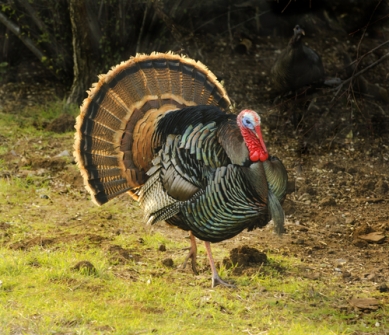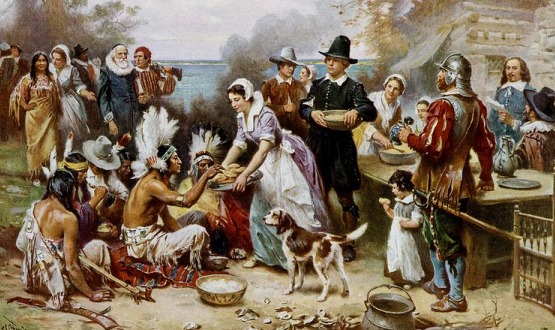
Thanksgiving — time to carve up a turkey, unbutton your pants, and watch football with the family. While families may have their own rituals, many Turkey Day customs have deep roots in American history.
From turkey pardoning to the first feast, here are the origins of seven of the holiday's most iconic traditions.
First feast
Most have heard the story: Pilgrims arrive at Plymouth Rock in 1621, nearly starve, are taught to farm by the locals, and after the first harvest, everyone has a gratitude-filled meal to celebrate. But settlers may have celebrated the first Thanksgiving farther south — at least if Texans have their say. Residents of San Elizario, Texas, claim the first Thanksgiving feast was celebrated in 1598 by Spanish explorer Juan de Oñate. After he and 500 fellow travelers survived a treacherous crossing through the Chihuahuan Desert in Mexico, the thirsty travelers gulped down water from the Rio Grande and devoured a Thanksgiving feast of fish and wild game to celebrate. America's first Thanksgiving feast may have even older roots still: Spanish admiral Pedro Menendes de Aviles is said to have celebrated the first Thanksgiving feast with 500 soldiers and hundreds of the local Timucuan Indians in 1565 in St. Augustine, Fla.
Turkey pardon
Every year, the president frees one lucky turkey while millions of its brethren are consigned to the dinner table. Though turkey farmers have been sending presidents the choicest birds since the 1800s, President John F. Kennedy was the first one on record to spare a turkey. In 1963, he sent back a turkey mailed by the National Turkey Federation, saying, "We'll just let this one grow." President Richard Nixon sent turkeys to a Washington, D.C., petting farm but didn't officially pardon them, according to the White House Blog. President George H.W. Bush gave the first official pardon to a turkey in 1989. The survivor lived out its days at a Virginia petting zoo called Frying Pan Park. [8 Terrific Turkey Facts]
Official holiday
Sign up for the Live Science daily newsletter now
Get the world’s most fascinating discoveries delivered straight to your inbox.
While Thanksgiving festivals were informally celebrated throughout the 1600s, they didn't become an annual event until the 1700s, when each state set aside a different day for the holiday. By 1775, George Washington, then commander-in-chief of the Continental Army, declared the first national celebration of Thanksgiving, and he issued a Thanksgiving Day proclamation in 1789. But the holiday didn't get a fixed date until 1863, when President Abraham Lincoln set aside the last Thursday in November for the day of thanks.
Turkey … and seafood?

Turkey Day should probably be called Surf 'n Turf Day if the historical celebration is any guide. Turkey may have been present at the first Thanksgiving but it definitely was not the centerpiece of the meal — that honor would have gone to deer meat brought by the Wampanoag Indians. While wild turkeys did roam the area, pilgrims probably preferred duck and goose. The first settlers' Thanksgiving also likely included a cornucopia from the sea, including lobsters, clams, mussels and even eels. Sweet potatoes and cranberry sauce probably weren't on the menu and probably didn't make it to the Thanksgiving table for at least another 50 years. [Video – Thanksgiving Food Safety]
Macy's parade
After a day of gorging, many Americans sit down to watch the Macy's Thanksgiving Parade. This annual tradition didn't get started until 1924, when Macy's employees held a Christmas parade filled with knights, clowns and jugglers. The 6-mile (9.7-kilometer)-long parade attracted a crowd of 250,000 viewers, and the department store decided to hold it every year. The first balloon, Felix the Cat, floated above the parade in 1927. Mickey Mouse didn't make his appearance until 1934.
Pigskin holiday
Another family pastime is Thanksgiving football, which has its roots in the Great Depression. After the Portsmouth Spartans moved to Detroit in 1930, the team's owner knew he had to do something to draw football fans to the new team. In 1934, he arranged a match between the Spartans (renamed the Lions) and the world champions, the Chicago Bears. Though the Spartans lost, a Thanksgiving tradition was born: The game sold out two weeks in advance, and the event became such a hit that it was repeated the year after. This time, the Lions prevailed.
Hybrid meats
The first settlers may have stuffed themselves with a range of meats at the dinner table, but the turducken is a fairly recent invention. A chicken stuffed inside a duck stuffed inside a turkey, the turducken has taken its place in the canon of over-the-top, calorie-laden Thanksgiving dishes. The dish first appeared in central Louisiana meat shops sometime between the late 1970s and early 1980s and was popularized by Cajun chef Paul Prudhomme. But the tradition of stuffing birds inside of other birds like Russian dolls may have even older roots: French foodie Grimod de la Reynière first described the rôti sans pareil (roast without equal) in L'Almanac des Gourmands between 1803 and 1812. The dish packs 17 birds inside one another, from a tiny warbler all the way up to a giant bird called a bustard.
Follow LiveScience on Twitter @livescience. We're also on Facebook & Google+.

Tia is the managing editor and was previously a senior writer for Live Science. Her work has appeared in Scientific American, Wired.com and other outlets. She holds a master's degree in bioengineering from the University of Washington, a graduate certificate in science writing from UC Santa Cruz and a bachelor's degree in mechanical engineering from the University of Texas at Austin. Tia was part of a team at the Milwaukee Journal Sentinel that published the Empty Cradles series on preterm births, which won multiple awards, including the 2012 Casey Medal for Meritorious Journalism.









